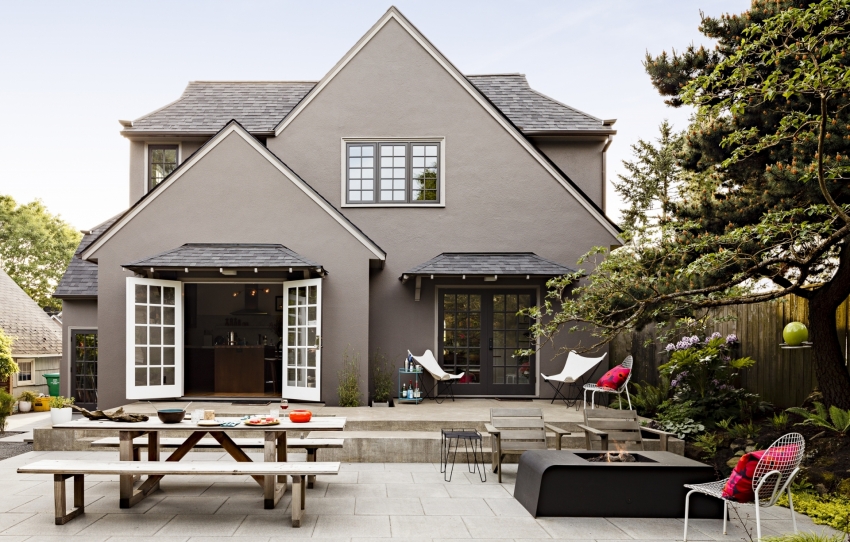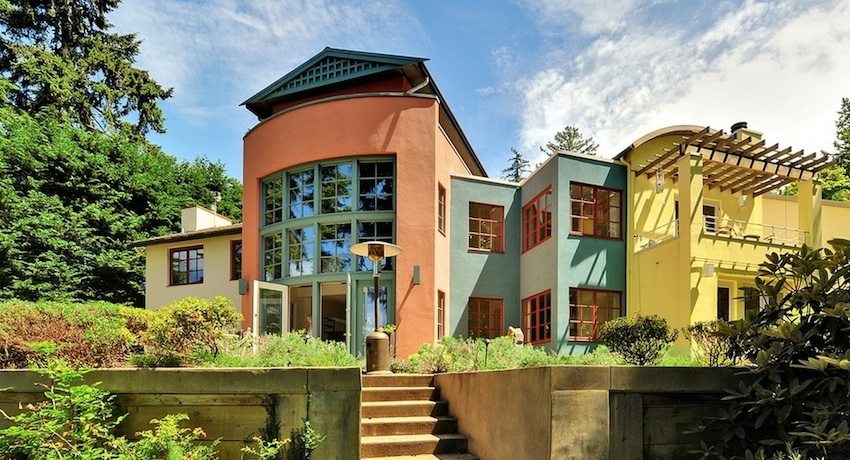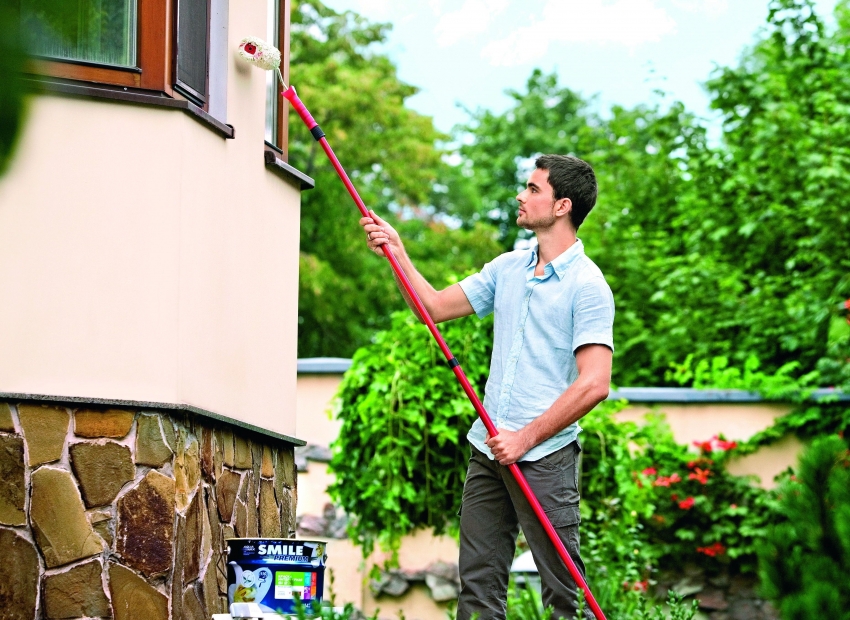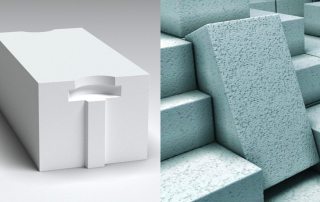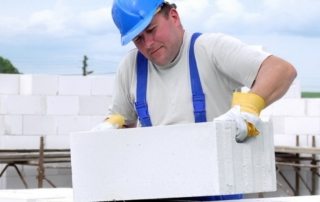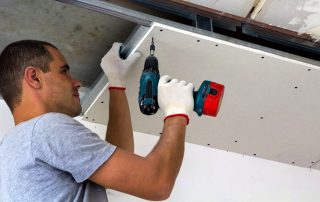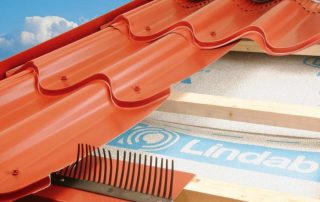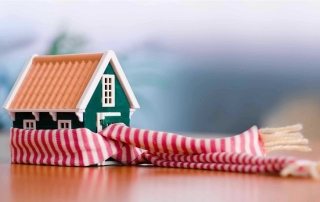From this article you can learn about the features of such a finishing material as facade paint for outdoor use: the price and technical characteristics of the compositions, their classification and specificity of operation, consumption, popular brands. The text discusses in detail the main varieties of dyes intended for finishing the facade of a building made of wood, brick or with a coating in the form of plaster.
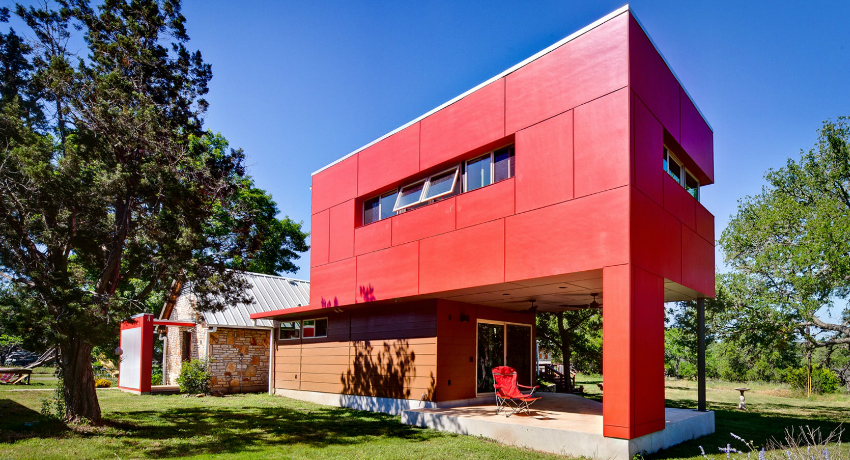
With the help of facade paint for exterior work, you can not only decorate the building, but also protect the walls from external factors
Content
Facade paint for outdoor use: the price of finishing materials and their features
Dyes intended for exterior decoration of buildings do not only have a decorative function. The capabilities of these compositions allow expanding the list of advantages of the coating, which provides effective protection of walls from the effects of temperatures, aggressive environmental factors, fungi and mold spores. The preservation of the appearance of the facade of the building, the terms of operation, as well as the cost of restoration depend on the properties and technical characteristics of the paint and varnish material.
Why is it profitable to buy facade paint for outdoor use as a finishing material
In addition to external decorative qualities, coloring compositions have many advantages, including numerous protective properties.
A high-quality dye for exterior decoration of a building forms a protective layer on the surface, preventing deep penetration of moisture from the environment into the walls. Rain and snow gradually wash away particles of a binder solution from walls covered with plaster or made in the form of masonry. As a result of this influence, the facade of the building loses its protective properties and appearance. Facade paint for wood prevents decay, material delamination and deforming changes. Under the influence of low temperatures, water penetrating deep into the walls expands and damages the structure, creating chips and cracks.The use of a quality dye for outdoor use avoids these unpleasant consequences.
The surface treated with the dye is reliably protected from the aggressive effects of chemicals, since the soil contains a large amount of mineral salts and active reagents. Also, the source of pollutants is car exhaust and industrial emissions. Under their influence, there is a gradual destruction of the masonry and mortars that hold the material together. As a result, there is a risk of destruction of the building. The dye significantly reduces the aggressive effect of such substances and other components. At the same time, the average price of facade paint for outdoor work varies between 270-900 rubles. for 1 kg of material.
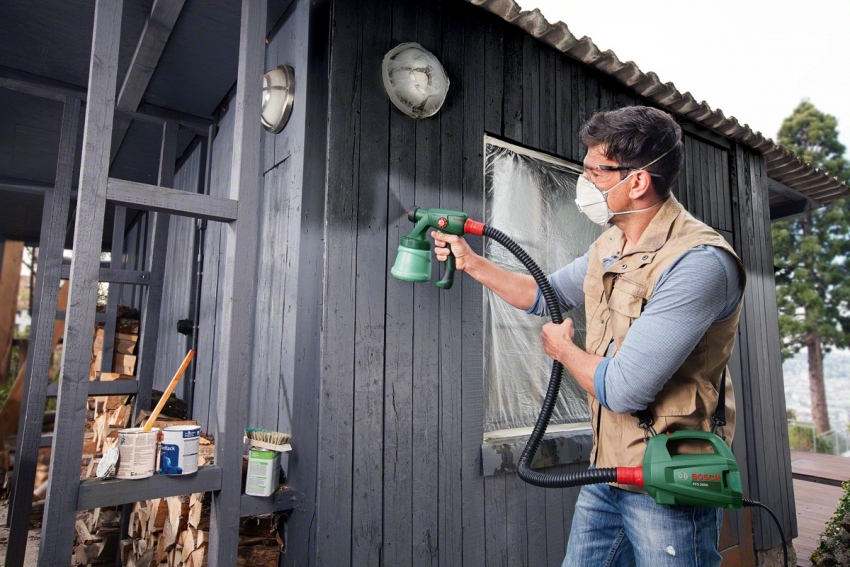
Before painting the facade of the building, it is worth carefully processing and preparing the walls in order to get a perfect surface without irregularities and drips.
Useful advice! To improve the adhesion of the exterior brick paint, it is recommended to pre-treat the substrate with an acrylic primer.
Advantages of facade paint for wood for outdoor use
Wood is often used as a building material for the construction of private houses. Given its vulnerability to external factors, such structures need enhanced protection, which can be provided with facade paint on wood.
Firstly, the composition prevents moisture from entering the walls, while the finish does not interfere with the natural process of movement of gases and steam. Due to this, the durability of the wooden building increases, as well as the formation of comfortable climatic conditions in the room.
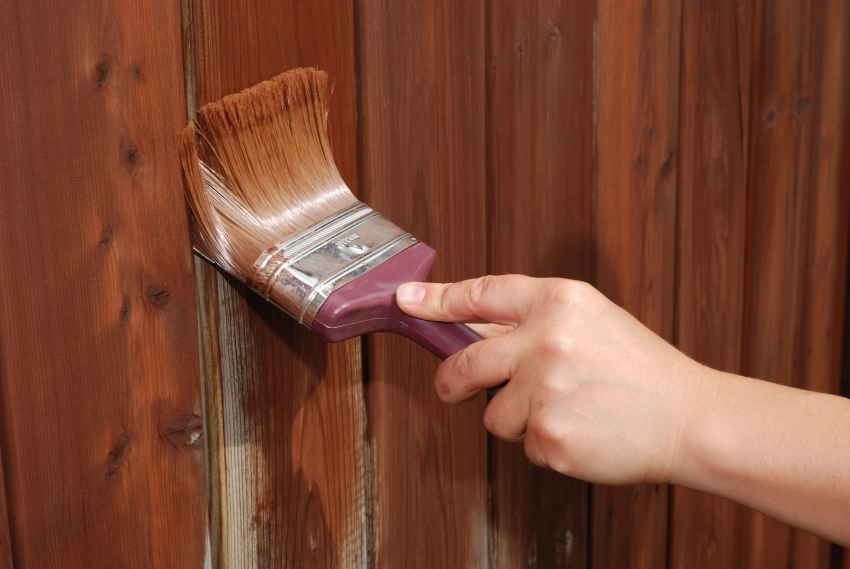
Facade paint for wood has not only a decorative function, but also protects wood from rotting and harmful fungi
Secondly, all high-quality paints for wooden facades contain antibacterial and antiseptic components. These properties of the finishing material prevent the appearance of microorganisms on the walls and further growth.
These microorganisms include:
- mold;
- mushrooms;
- bacteria;
- moss and other forms of biological life.
Some types of acrylic facade paints for wood for outdoor use increase the fire safety of buildings due to the presence of fire retardants in their composition.
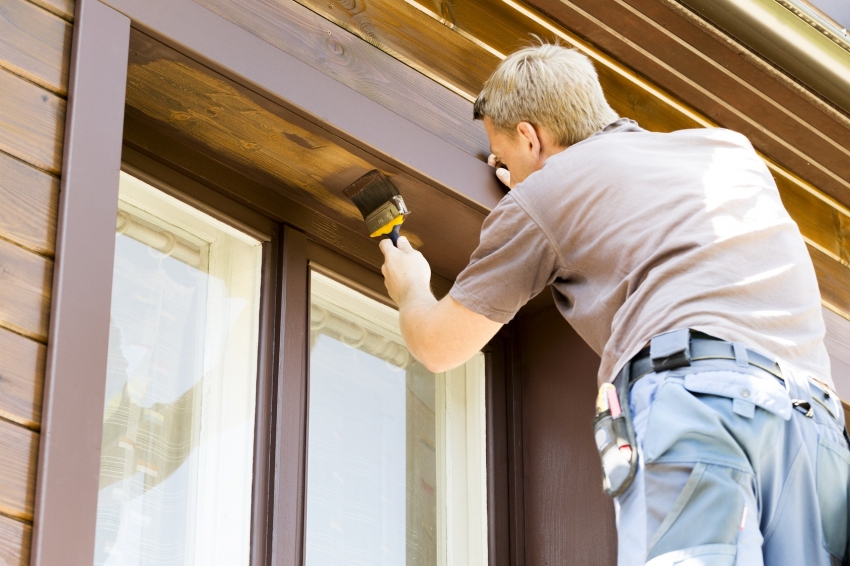
Most quality facade paints for wood have fire retardant properties
Note! The dye does not provide complete home fire protection, it only reduces the risk of fire. Such compounds slow down the combustion process, as a result of which the owner of the building has more time to evacuate and eliminate the fire.
Organic-based facade paint: composition properties
In terms of composition, almost all dyes are the same and include the following components:
- base in the form of a solvent;
- binder (an element that promotes the formation of a film on the treated surface;
- pigment additives (colors that provide the composition with a certain shade);
- fillers to create additional shine or texture;
- additives that provide protection and improved properties;
- plasticizers.
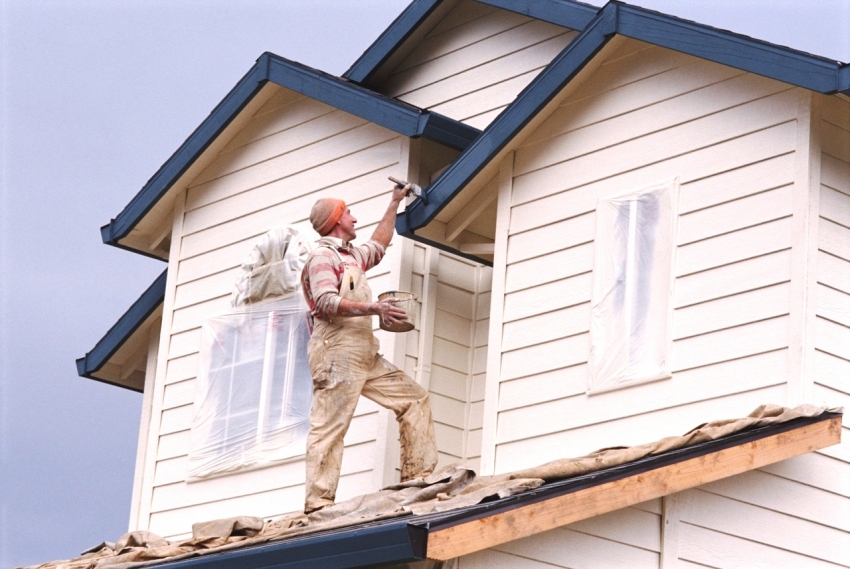
Organic-based paint is considered more resistant than water-based paint, therefore painting with such a composition is more durable
According to the type of base, all dyes are divided into organic and water-dispersed compositions. Each variety has its own advantages, application features and technical parameters. Solvents such as white spirit are used as a base for organic dyes. More modern types of paints and varnishes have appeared on the market, however, leading manufacturers continue to produce compositions on an organic basis. The popularity of such finishes is not decreasing, and in some cases the use of other options is simply impossible.
Organic compounds are most often presented in the form of frost-resistant exterior paints for outdoor use. Due to this, the application process can be carried out with high quality even at low temperatures. In addition, the protective properties of the dye are manifested even at the drying stage, when the coating surface is not yet stabilized. Therefore, with the help of organic compounds, you can finish the building without waiting for summer to come.
Organic paint is also used to cover walls finished with conventional façade or decorative exterior plaster. This type of coating allows you to increase the vapor permeability of the walls and solve the problem of dampness. The price of facade plaster for outdoor use is affordable, therefore this type of coating is one of the most popular among owners of private houses.
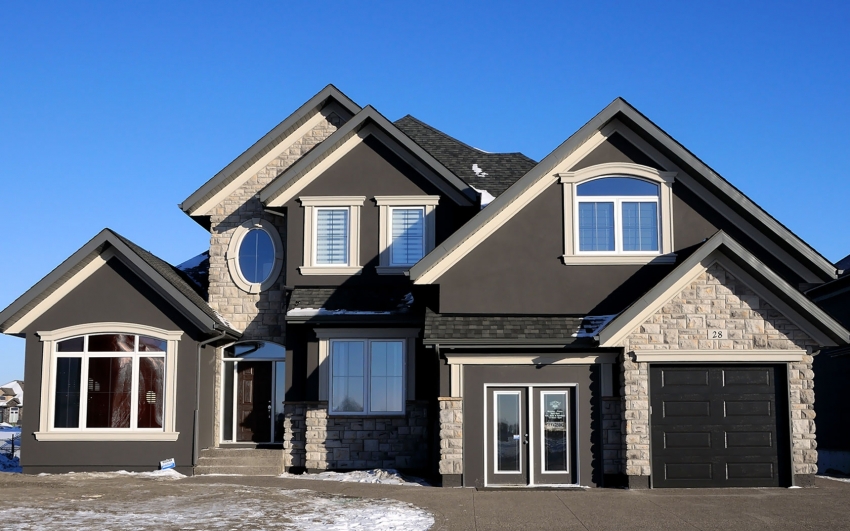
Coating with facade paint is beautifully combined with both brickwork and artificial stone or decorative plaster
Organic facade paints for plaster for outdoor use: the price of quality compounds
One of the most popular paint manufacturers is the British company Dulux. Under this brand name, a line of white spirit-based wall finishing compounds is produced. The range of colorants allows you to select the material for creating a coating with a glossy or matte effect. The products are characterized by environmental friendliness and a high level of quality that fully complies with European standards.
Note! When buying Dulux paint, you can choose the shade yourself using the manufacturer's catalog. Each company store uses machines for tinting the formulations, and the dyes themselves have a colorless base.
The average price of organic-based Dulux facade dyes is 900 rubles / kg.
Duparol is another facade dye in demand among consumers. Its manufacturer is the world famous company Caparol.
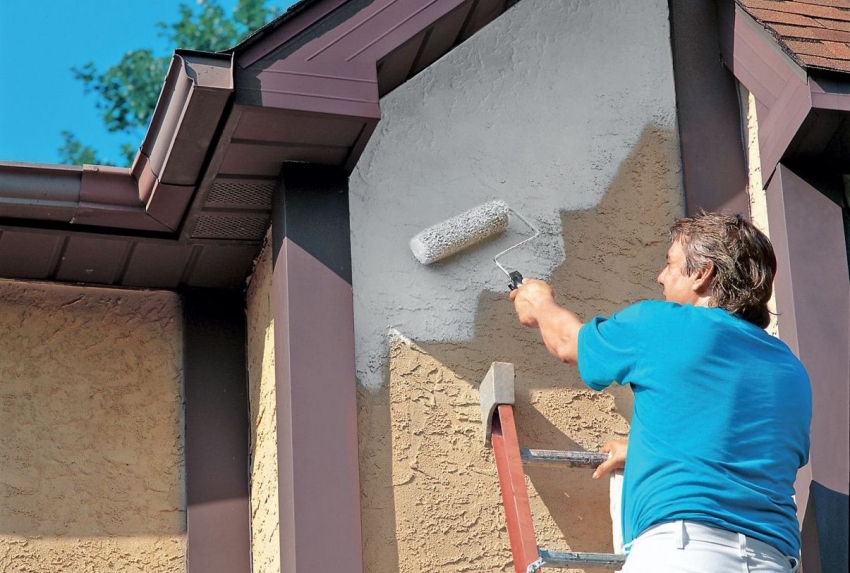
There is a special line for decorative plaster dyesthat protect and decorate the surface
Decorating a building with Duparol paint will be a universal solution to several serious problems at once:
- dampness;
- old spots;
- soot;
- mold.
The manufacturer offers customers to buy dyes in white or compositions with a colorless base that can be tinted. The range includes glossy and matte finish options. The average cost of such dyes is 500 rubles / kg.
Water-dispersed facade paints: the price of acrylic, silicate and silicone composition
Water-based formulations represent a broad category of artificial-based dyes. Acrylic resins can act as a binder, "liquid glass" or silicone resins. Thanks to this variety, the consumer can buy acrylic facade paint, silicone or silicate. Each of them has its own advantages, technical and operational characteristics.
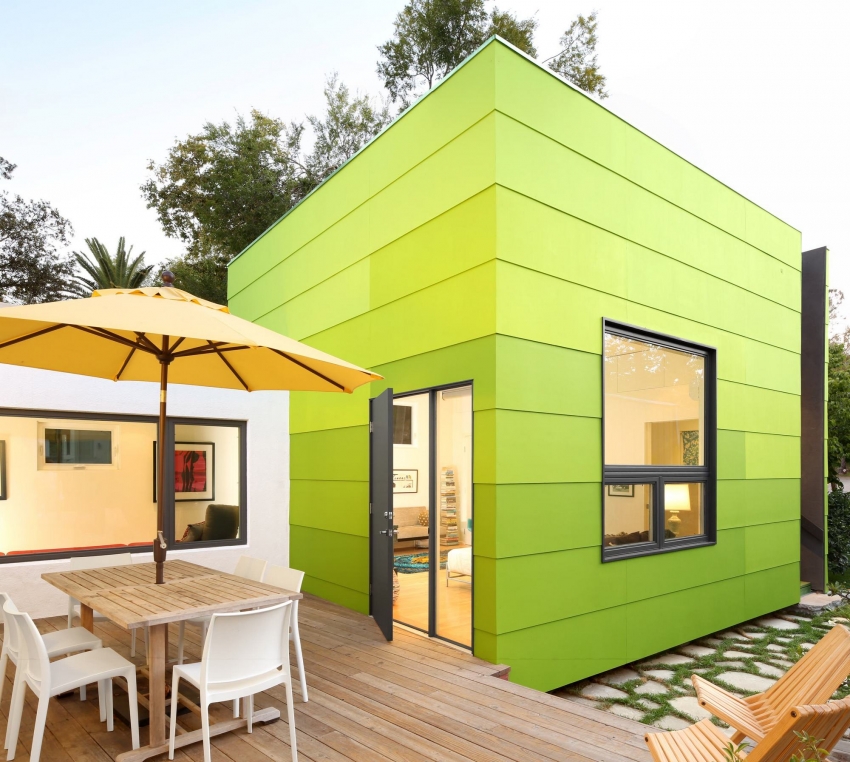
Most facade paints have a white base, and you can add color in the store or on your own by adding color
Features of outdoor acrylic paint
The finishing material contains polyacrylic polymers, which form a film coating on the treated surface. Due to the technical characteristics of exterior acrylic facade paint, price and numerous advantages, it is one of the most popular and practical materials on the market.
The composition of acrylic-based dyes contains:
- Binder - forms a strong film coating and binds paint fillers and pigments together, and also increases the adhesive properties of the composition.
- Fillers are responsible for the physical characteristics and properties of the coating. These include the water resistance of the finish, the presence of a gloss or matt effect, the level of durability, etc.
- Pigments - are fine particles that give the dye certain possibilities and decorative characteristics. These include resistance to corrosion, removal of transparency and giving the base the required shade. In combination with a binder, the pigments decorate and protect the surface of the walls.
- Additional substances - emulsifiers, thickeners, stabilizers, defoamers and other auxiliary components.
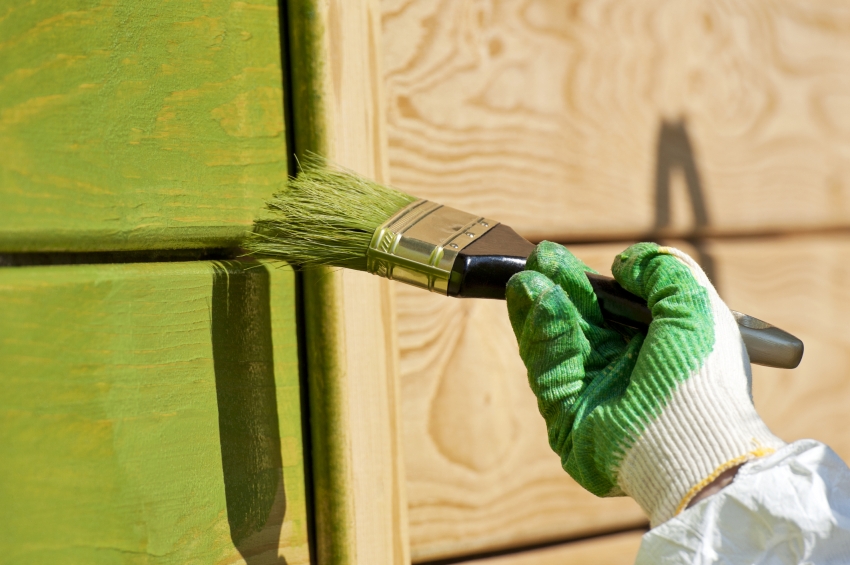
The number of layers of application depends on the consistency of the paint to obtain the desired shade of the walls
Note! Acrylic water-dispersed dyes are universal. Due to the elasticity of the coating, you can not only finish the new facade, but also restore the appearance of the old one. The composition is perfectly combined with any type of surface: aerated concrete, brick, concrete, stone, wood, plaster.
The average cost of acrylic paint for external coating is 80-130 rubles / kg, but it is worth considering that you can buy facade paint from more well-known manufacturers starting from 400 rubles / kg. As a rule, such formulations are distinguished by improved performance characteristics and additional capabilities.
Related article:
Facade paint on plaster for outdoor use: properties and types
The choice of paint for outdoor use and its varieties. Advantages and disadvantages. Surface preparation and coating.
Parameters of acrylic facade paint: technical characteristics, price
The optimal composition of the acrylic dye provides it with beneficial advantages and technical characteristics. This type of coating, due to its polymer binder, has the following features:
- high strength of the coating in the form of a film;
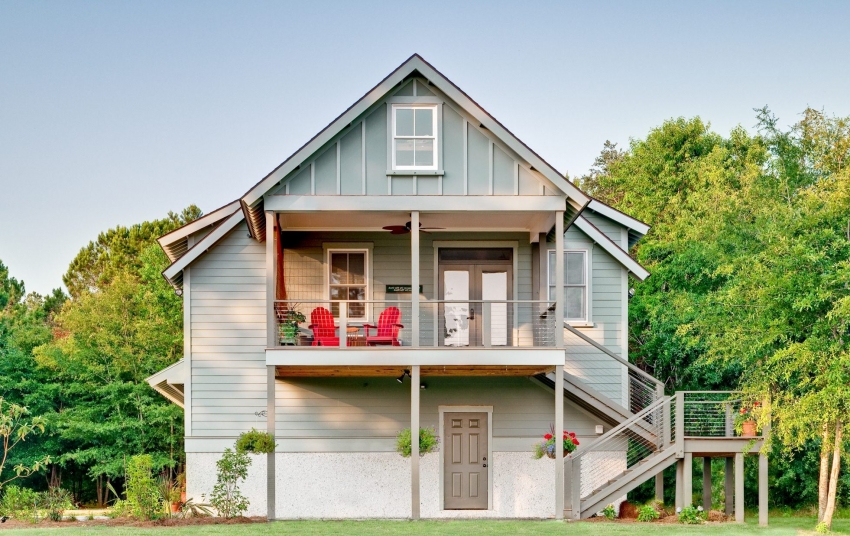
Acrylic paint has a high level of vapor permeability and is resistant to moisture penetration, therefore it is recommended to use it for buildings located near water bodies
- the ability to use on surfaces with a porous structure;
- elasticity;
- fast drying time, accelerating the process of wall decoration;
- resistance to negative atmospheric factors;
- vapor permeability;
- resistance to moisture penetration.
Under the condition of two-layer application of facade paint per 1 m2 on plaster, the consumption of acrylic composition is minimal and amounts to about 250-300 g. This indicator depends on the material from which the walls are made. The covering capacity of the dried film does not exceed 100 g / m³.
The surface to be painted can also have varying degrees of roughness and absorbency. Taking this into account, the maximum value of the consumption of facade paint per 1 m2 increases to 500 g. The service life declared by the manufacturer is 10 years or more.
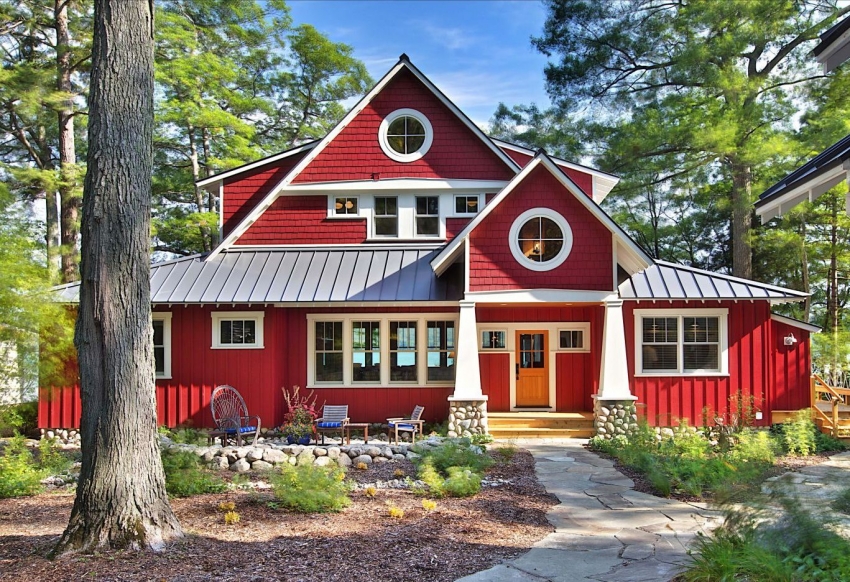
In order to reduce the consumption of paint for facades, the surface should be treated with special means
The most popular in the market are Tikkurila dyes. All formulations of this brand go well with each other. The range of the manufacturer includes dyes for all types of surfaces, including slate and wood, as well as special products that are used to prepare the surface before painting.
The price of Tikkurila facade paint for exterior works ranges from 500 to 800 rubles. for a can of basic composition. The cost acrylic stains for woodcontaining oils, are in the range of 2300-7000 rubles.
For comparison, you can consider the budget option of Teks facade paints. Compositions for universal use cost from 385 rubles. Mixtures for professional use with frost-resistant properties have a cost in the range of 1500-1700 rubles.
Features and prices of silicate facade paint for outdoor use
Silicate water-dispersed dyes have a rather narrow scope of application. Physico-chemical characteristics limit the choice of shades.The presence of lime and alkaline components in the dye does not allow the use of pigments in sufficient quantities, therefore the color palette cannot offer consumers a great variety.
Silicate glue is used as a binder. The average consumption of this type of facade paint is about 140-150 g / m², and the service life is 20 years. This is made possible by the high level of vapor permeability, due to which moisture does not accumulate under the coating.
Important! Silicate paint is incompatible with natural wood, as well as artificial materials such as PVC, polypropylene and other types of plastics. It is forbidden to cover the stone surface with the composition, which contains resin, vinasse and other components of organic origin.
Most often, dyes based on "Liquid glass" used for painting mineral surfaces of cement, limestone or cement-plaster type. It can be used for interior decoration on concrete, red or silicate brick, plaster and clay. The average price of the dye is 3400-4500 rubles. per packing.
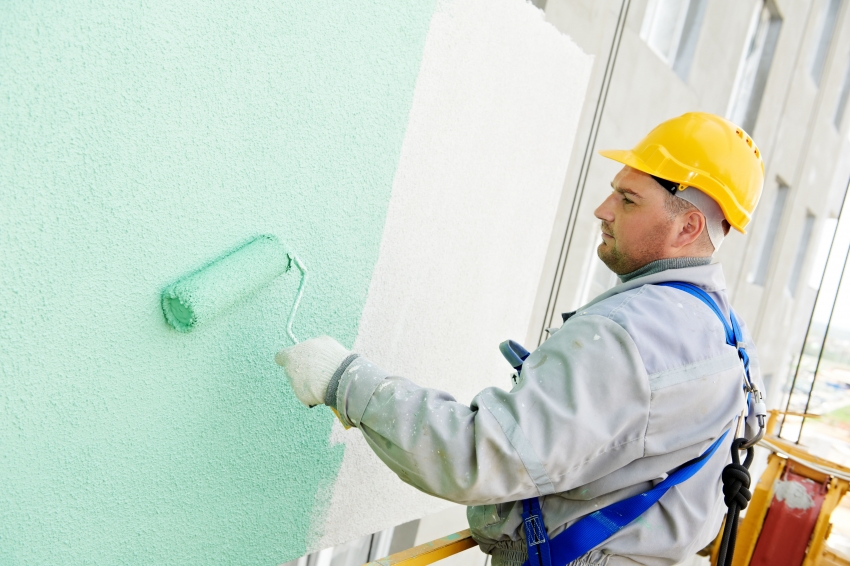
Dyes based on "Liquid glass" also used to cover facades of multi-storey buildings
The advantages of this type of composition include:
- high biological resistance;
- resistance to ultraviolet radiation and temperature changes;
- long service life of the coating.
Among the disadvantages of silicate paint is toxicity, forcing to observe safety measures during work and use protective equipment. In addition, the finish cannot be washed off at all, so you need to work with such a composition carefully.
Characteristics of Exterior Silicone Facade Paint
Silicone paint for facades combines the advantages of latex and silicate coatings. This type of composition has a high degree of elasticity, while it does not react to the influence of high temperatures (there is no thermoplasticity).
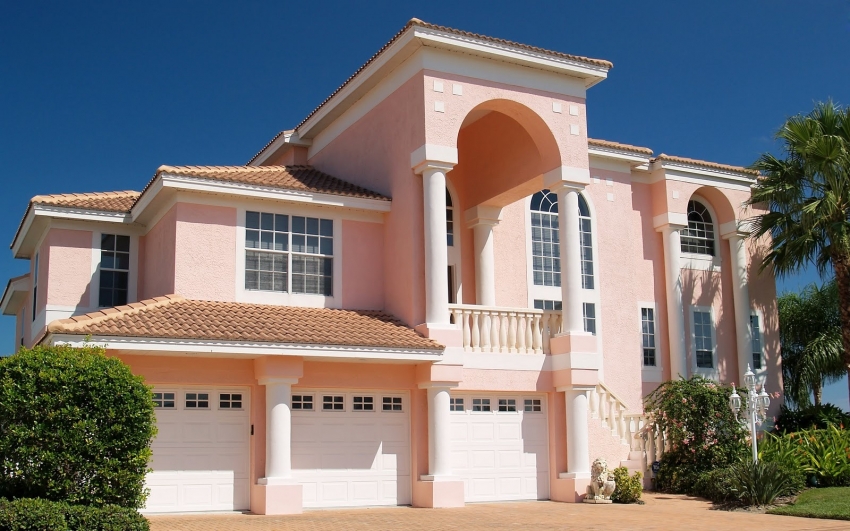
Some types of compounds repel water and dirt, which is very convenient when covering walls with light shades of paints
Silicone-based dyes are characterized by high vapor permeability. At the same time, the surface of the coating is good at repelling water. As a result, the walls are self-cleaning during rainfall. There is no need to use special antibacterial primers, since all the components necessary to protect the walls are already in the composition. The consumption of silicone-based facade paint is on average 200 g per 1 m².
Tikkurila Kivisil silicone facade paint is especially popular among consumers. The price of the composition is 500-550 rubles / kg. Also, Lotusan Color paint from the German company Sto AG is in demand at a cost of 570-600 rubles / kg (colorless base).
A wide range of paints and varnishes on the market allows you to choose a dye taking into account the base material, decorative requests, the budgetary possibilities of the owner of the house, as well as other necessary properties. In addition to the main varieties, there are modified compositions. They are latex dyes with an admixture of silicone additives, due to which the coating acquires improved qualities. Such dyes are produced by Baltic Color and Akzo Nobe. Thus, facade paint can fully replace other options for finishing materials.
